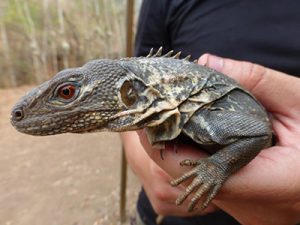Stats

species Information
Habitat
- The Motagua Spiny-tailed Iguana is endemic to Guatemala and is restricted to the last remnants of seasonally dry tropical forest in the Motagua Valley in eastern Guatemala. It has an estimated population size of about 2,500 adult individuals.
- These iguanas are primarily arboreal, using hollow trunks or branches as shelters. They typically go in head first, using the spiny tail to block the entrance. The iguanas climb to the crown of trees or the highest part of cactus for basking during the day.
This species is particularly associated with the endangered Pitayo Organ Pipe Cactus (Stenocereus pruinosus) and plays a key role in dispersal of its seeds, helping to maintain the dry forest habitat.
Diet
- The Motagua Spiny-tailed Iguana is omnivorous. It feeds on plant fruits, flowers, and leaves, and on insects, including ants and crickets.
- It particularly seeks out the fruit of the Pitayo Organ Pipe Cactus, and individuals have been observed with faces and forelimbs colored red by the pigment in the fruit.
- Research has shown that the cactus seeds eaten by the iguana show a significant increase in germination success.
Reproduction
- Females have an annual reproduction cycle.
- They nests in banks of dry streams and gullies and in sandy patches within the dry forest, digging tunnels in which they lay their eggs.
- Six to 12 eggs are deposited from late March to late April. Eggs begin hatching in late May, which coincides with the beginning of the rainy season.
Conservation
- The main threat for Motagua Spiny-tailed Iguanas is over-harvesting by local people for meat and eggs. Habitat loss is also a problem for the iguana, primarily due to the increased production of melon crops and the construction of new residential zones within the Motagua Valley.
- Conservation strategies have been taking place in the Motagua Valley for more than 10 years. Part of the population is protected within the Heloderma Natural Reserve (HNR), managed by the Guatemalan nonprofit organization Zootropic. Management of this species includes a conservation breeding program within the reserve and an education program reaching more than 1,500 children each year.
- Ten more national parks have suitable habitat for the species and offer legal protection from habitat destruction and poaching. However, enforcement is lacking and needs to be strengthened to conserve the species.
International Iguana Foundation Grants
Consolidation of Motagua Spiny-tailed Iguana (Ctenosaura palearis) habitat restoration and research, and of the youth iguana conservation task force “Iguaneros” in Guatemala
Johana Gil-Escobedo
$10,000
Consolidation of community-based conservation and research for the Motagua Spiny-tailed Iguana (Ctenosaura palearis) in Guatemala
Johana Gil and Daniel Ariano
$24,808
Strengthening Heloderma Natural Reserve as a conservation education center and tree nursery for iguana habitat restoration of the iguana species of the Motagua Valley, Guatemala
Johana Gil and Daniel Ariano
$11,920
Expanding the elementary education program for the conservation of the Guatemalan Spiny-tailed Iguana (Ctenosaura palearis) at the influence area of Heloderma Natural Reserve
Daniel Ariano and Johana Gil
$5,000
Expanding the elementary education program for the conservation of the Guatemalan Spiny-tailed Iguana (Ctenosaura palearis) at the influence area of Heloderma Natural Reserve
Daniel Ariano and Johana Gil
$11,157
Education for Conservation, Habitat Protection and Population Reinforcement of the Motagua Spiny-tailed Iguana (Ctenosaura palearis) at Heloderma Natural Reserve and its Area of Influence
Daniel Ariano and Johana Gil
$11,887
Reinforcement of Education for Conservation and Habitat Protection of the Endangered Guatemalan Spiny-tailed Iguana (Ctenosaura palearis) at Heloderma Natural Reserve and its Area of Influence
Daniel Ariano
$7,728
Community Outreach and Capacity-building for Long-term Conservation of the Endangered Motagua Spiny-tailed Iguana (Ctenosaura palearis)
Daniel Ariano
$10,970
Education for Conservation of the Endangered Motagua Spiny-tailed Iguana (Ctenosaura palearis) as a Key Seed Disperser in the Seasonally Dry Forests Surrounding Four Rural Communities in Eastern Guatemala
Daniel Ariano and Johana Gil
$10,830
Assessment of the Seed Dispersal Ecosystem Service Given by the Endangered Guatemalan Spiny-tailed Iguana (Ctenosaura palearis) in Guatemala, as a Tool to Promote In-country Conservation of the Species and its Habitat Through Ecosystem Services
Daniel Ariano and Johana Gil
$10,240
Increasing Local Capacities for the Conservation of the Critically Endangered Ctenosaura palearis in the Seasonally Dry Tropical Forests of Eastern Guatemala
Daniel Ariano and Luis Alvarado
$10,433






